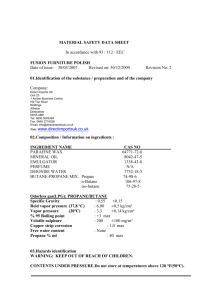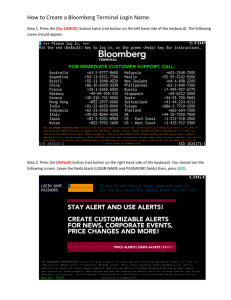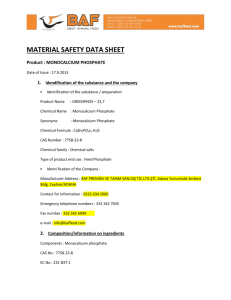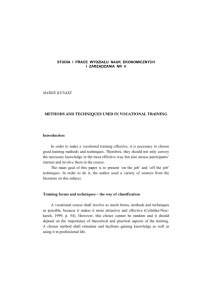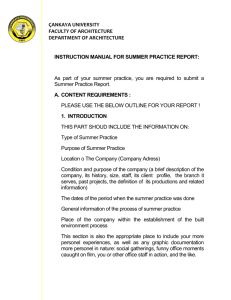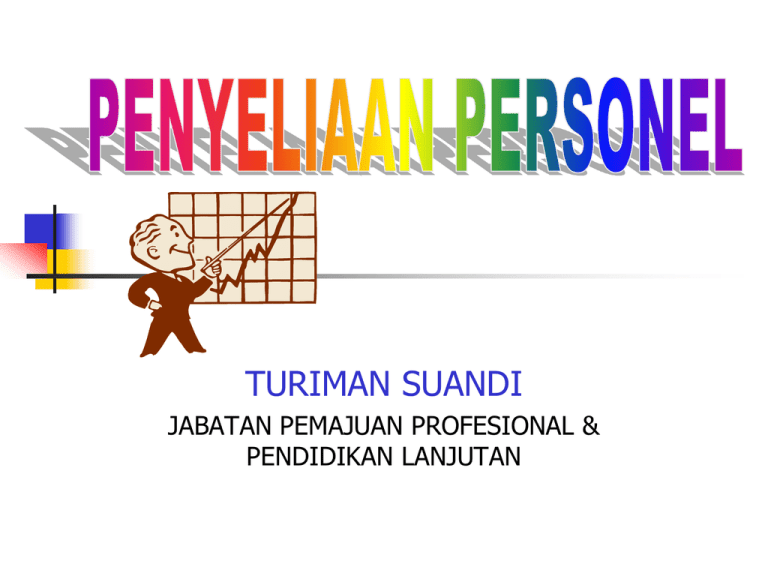
TURIMAN SUANDI
JABATAN PEMAJUAN PROFESIONAL &
PENDIDIKAN LANJUTAN
Pelajar dapat meningkatkan pengetahuan
mengenai asas & teori penyeliaan personel,
peranan penyelia personel, komunikasi,
motivasi, kepemimpinan, pembangunan staf &
latihan, keselamatan & kesihatan pekerja dan
penilaian prestasi
3/22/2016
PENYELIAAN PERSONEL
2
HASIL PEMBELAJARAN
Pada akhir kursus ini pelajar dapat:
Menerangkan konsep & prinsip penyeliaan personel
Menghuraikan peranan penyelia personel
Menghuraikan elemen komunikasi, motivasi,
kepemimpinan, pembangunan staf & latihan,
keselamatan & kesihatan pekerja, &penilaian prestasi
Mempamerkan kemahiran dalam mengendalikan
penyeliaan personel yang berkesan
3/22/2016
PENYELIAAN PERSONEL
3
Setiap pelajar perlu:
3/22/2016
Komited dalam mempamerkan
kemampuan & potensinya untuk mendapat
gred yang terbaik & pendedahan
maksimum untuk menjadi seorang
penyelia personel yang cemerlang
PENYELIAAN PERSONEL
4
TUGASAN
Menyempurnakan satu kertas kerja (30%)
3/22/2016
berdasarkan mana-mana aspek daripada unit dalam
modul
menggunakan kertas A4 langkau 2 baris
dengan artikel panjangnya 20 muka surat.
PENYELIAAN PERSONEL
5
UJIAN
Menduduki 1 (satu) UJIAN PERTENGAHAN
semester yang akan ditentukan oleh pihak UPMET
tarikh dan waktunya (30%)
Menduduki PEPERIKSAAN AKHIR semester yang
akan ditentukan oleh pihak UPMET tarikh dan
waktunya (40%)
3/22/2016
PENYELIAAN PERSONEL
6
UNIT 1
Konsep Penyeliaan Personel
UNIT 8
Penilaian Prestasi
Pekerja
PENYELIAAN
PERSONEL
UNIT 3
Komunikasi Dalam Organisasi
UNIT 4
Keperluan & Motivasi Pekerja
UNIT 7
Pengurusan Konflik & Tekanan
UNIT 6
Latihan & Pembangunan
3/22/2016
UNIT 2
Fungsi Penyelia Personel
PENYELIAAN PERSONEL
UNIT 5
Kepimpinan & Stail Pengurusan
7
UNIT 1
KONSEP PENYELIAAN PERSONEL
Objektif Unit
Pada akhir unit ini pelajar dapat:
3/22/2016
Menerangkan teori berkaitan dengan
pentadbiran, pengurusan dan penyeliaan.
Menerangkan hubungan antara
pentadbiran, pengurusan dan penyeliaan.
PENYELIAAN PERSONEL
8
Successful Supervisors
Develop the ability to balance the
requirements for high work performance with
the diverse needs of the workforce.
The Challenges and Rewards of Supervision
Getting diverse people to work together
Increased responsibility that comes with climbing
the management hierarchy
The unpredictable nature of the job
The sense of accomplishment from doing a job
well
Managing organizational pressures and conflict
Supervisors
First-level managers in charge of entrylevel and other departmental employees.
Working Supervisors
First-level individuals who perform
supervisory functions but who may not
legally or officially be part of management.
Foreman/forewoman, group/team leader, lead
person, coach, and facilitator
Schools of Management Thought
Scientific Management Approach (Taylor)
Focuses on determining the most efficient ways to increase
output and productivity.
Analyze the tasks using the principles of science to find the one
best way to perform the work.
Recruit the employee best suited to perform the job.
Instruct the worker in the one best way to perform the job.
Reward the accomplishment of the worker.
Cooperate with workers to ensure that the job matches plans
and principles.
Ensure an equal division of work and responsibility between
managers and workers.
Functional Approach
Asserts that all managers perform similar functions in doing
their jobs—the universality of management.
A manager’s authority should equal that manager’s
responsibility and that the direction and flow of authority
through an organization should be unified.
Five functions of management (Fayol)
1. Planning: Setting down a course of action.
2. Organizing: Designing a structure, with tasks and authority
clearly defined.
3. Commanding: Directing subordinates’ actions.
4. Coordinating: Pulling organizational elements toward common
objectives.
5. Controlling: Ensuring that plans are carried out.
Human Relations/Behavioral School
Focuses on the behavior of people in the work
environment in the belief that:
1.if managers used the principles of scientific
management, worker efficiency would increase and
productivity increases would follow
2.if managers strove to improve working conditions,
productivity would increase.
Hawthorne Studies
Hawthorne Effect
The fact that special interest shown in people may cause
those people to behave differently.
Quantitative/Systems Approaches
Use mathematical modeling as a foundation in
attempting to quantitatively describe the
interrelationships of variables through data, data
can be manipulated and outcomes predicted.
Develop mathematical models as series or
collections of interrelated variables or parts that
can be analyzed and used in decision making.
Are frequently found in large organizations where
sales, costs, and production data are analyzed
using computer technology.
Factors And Trends Affecting The
Role Of The Supervisor
Diversity
Population and Workforce Growth
The cultural, ethnic, gender, age, educational level, racial,
and lifestyle differences of employees.
Continued growth in both.
Better educated but many employees lack basic skills
Changing Age Patterns
The workforce will continue to grow older.
Generation Xers (1964–1981)
Boomers (1946–1963)
Matures (before 1945)
Effective supervisors must be adaptable and be
able to maintain their perspective in the face of
rapidly changing conditions.
Supervision: A Professional
Perspective
Supervisors manage their firms’ most
important resources—human resources.
Supervisors who want to be more effective:
Can develop the habits of highly effective people
Recognize the need for continuous selfdevelopment and renewing the four dimensions of
their nature—spiritual, mental, social / emotional,
and physical
UNIT 2
FUNGSI PENYELIA PERSONEL
Objektif Unit
Pada akhir unit ini pelajar dapat:
3/22/2016
Menerangkan fungsi utama penyelia.
Menerangkan delegasi autoriti yang boleh
dibuat oleh penyelia.
PENYELIAAN PERSONEL
21
Major Functions of Supervision
• Studying the teacherIntrospection learner situation
Research
• Improving the
Training
teacher –learner
situation
Guidance
Evaluation • Evaluating the
means, methods, and
outcomes of
supervision
Supervision
Emphasis
Emphasis
Emphasis
Emphasis
Emphasis
Emphasis
on
on
on
on
on
on
Administration
Curriculum
Instruction
Human Relations
Leadership
Evaluation
Administration Dimension of
Supervision
The Administrator
Administer process, programs and services,
and personnel
Task planning, setting, and prioritizing of
goals, establishing standards and policies,
budgeting, allocating resources, staffing,
coordinating and monitoring performance,
conducting meetings, and reporting
Interact with …
Communicate …..
Purpose- provide effective instruction to
their clientele
Administration of Process
Initiates the planning of programs and
strategies
Long-range: on in-depth needs
assessment, based on clear goals and
objectives
Short term: immediate needs of the
incoming school year
Administration of Budget
- prepare and administer the approved
budgets
- Is business poles apart?
1) Capital Budget
2) Personnel Services
3) Operating Expenses
5 Phases of the Clinical Sup
Planning
Reflection
Feedback
Observation
Analysis
What is management?
Management is not carrying out a
prescribed task in a prescribed way:
Management is:
Setting directions, aims, and objectives
Planning how progress will be made
Organizing available resources
Controlling the process
Setting and improving organizational
standards
Valuable Practices
Learning how to run a successful business
Automating your facility
Sound financial planning
Establishing effective marketing and public
relations strategies to promote your services
Knowing, implementing, and often
exceeding licensing standards
Being aware of legal issues
Developing a work plan (assigning roles
and responsibilities).
Action plan
The Manager and his Roles
(1) integrate its resources in the
effective pursuit of its goals
(2) be agents of effective change
(3) maintain and develop its resources
ETHICS AND THE MANAGER
The manager is the leader and has
potential powerbase
Whether the staff are happy or unhappy
with their work
Their work priority
Standard which they observe and
reflect
Mangement: Art or Science
Art
art is based on the fact that a
man, receiving through his
sense of hearing or sight
another man's expression of
feeling, is capable of
experiencing the emotion which
moved the man who expressed
it.’
Science
The scientific nature of
management is
reflected in the fact that
it is based on a more or
else codified body of
knowledge consisting of
theories and principles
that are subject to
study and further
experimentation.
Organizational Goals
There should not
only be a clear
sense of direction
but also markers
whereby we can
assess progress
from the broad to
the more specific.
Goals
Targets
Success Criterias
Milestones
Models of Organizational
Behavior
The Classical Model
Emphasizes characteristics such as rationality, high
job specialization, centralization, a command system,
a tight hierarchy, strong vertical communication, tight
control, rigid procedures and an autocratic approach.
• Rational Systems: A Machine Model
• Individuals can be programmed to be efficient machines.
Workers are motivated by economics and by limited
physiology, needed constant direction.
Rational Systems Model
Frederick Taylor – “Time and Motion”
studies.
Henri Fayol- administrative behavior
consist of Planning, organizing,
commanding, coordinating and
controlling.
Luther Gulick- POSDCoRB
- principle of
homogeneity
Rational Systems:
Concepts and Propositions
Goals
Division of Labor
Specialization
Standardization
Formalization
Span of Control
Hierarchy
Exception Principle
Coordination
Humanistic Model
respect for the individual and other human
values, job breadth, consultation,
consensus, decentralization, loose project
organization, flexible procedures,
multidirectional communication,
management by objectives and a
participative approach.
Natural Systems
Natural System
“the fundamental problem in organizations was
developing and maintaining dynamic and harmonious
relationships”.
Mary Parker
Follet
Natural-systems view focuses on similarities
among social groups, thus driven primarily by
the goal of basic survival-not goals of the
institutions.
Individuals are never simply hired hands but
bring along with them their heads and hearts.
Concepts and Propositions
Survival
Individual
Needs
Specialization
Formalization
Informal Norms
Hierarchy
Span of Control
Communication
Informal
Organization
Comparison
Rational Systems
Structure without
people
Formal
Structural
arrangements
Organizational
demands
Natural System
People without
organization
Informal
Social groups trying
to adapt
Human needs
Open System: An Integration
A reaction to the unrealistic assumption that an
organizational behavior can be isolated from
external forces.
Organizations are not influenced only by the
environment but also dependent on them.
“The opens systems model stresses reciprocal
ties that bind and interrelate the organization
with those elements that surround and penetrate
it. Indeed, the environment is even seen to be
the source of order itself”.
Social System
The school is a system of social
interaction; it is an organized whole
comprising interacting personalities
bound together in an organic
relationship, interdependence of parts,
clearly defined population,
differentiation from its environment, a
complex network of social relationships,
and its own unique culture.
Social Systems
Key Elements of the Social Systems
Model
Structure
Culture
Politics
Environment
Outcomes
Systems Model: Management
Cybernetics
Stafford Beer
Has taken the metaphor of living organisms a
stage further. Human physiological is applied
to industrial organizations. It states that
there are 5 tiers of the subsystems in the
central human nervous system, which have
their counterparts in the organization. The
successful survival of the human is an
evidence of the effectiveness of such a
system. Diagnose in what respects they fall
short and strengthening the subsystem that
seem weekly developed.
Management Cybernetics
examine the health or viability of an
existing organization
evaluate the proposals for new
organization structures; and
clarify the purpose of committees or
roles.
Management Cybernetics
The model can be used in three main
ways:
examine the health or viability of an
existing organization
evaluate the proposals for new
organization structures; and
clarify the purpose of committees or
roles.
Contingency Model
Organizations should be different from
one another and from part to part.
Organizations left to themselves
organization departments and
individuals tend toward specialization,
carving out a more distinctive niche for
themselves.
Effective Integration
Each unit or individual can report to a manager
who is made accountable for synergizing the two
roles
a third unit or individual seen by the other two as
understanding their roles and standing as a midway
between them, act as intermediary
some kind of training or image exchange can be
undertaken to help each unit understand more
accurately why the other units behaves as it does.
Interdepartmental groups or task force to resolve
issues between departments. Tis can be temporary
or permanent
Elements of Organizations
Technology
Structure
People
Culture
Hallmarks of Effective Schools
Professional Leadership
Shared vision & goals
Learning Environment
Concentration on Learning and
Teaching
High Expectations
Positive Reinforcement
Monitoring Progress
UNIT 3
KOMUNIKASI DALAM
ORGANISASI
Objektif Unit
Pada akhir unit ini pelajar dapat:
3/22/2016
Menerangkan proses komunikasi yang
perlu dilalui oleh penyelia.
Membincangkan kaedah pengucapan
awam yang berkesan
PENYELIAAN PERSONEL
53
Communication
Communication - the evoking of a shared or common
meaning in another person
Interpersonal Communication - communication
between two or more people in an organization
Communicator - the person originating the message
Receiver - the person receiving a message
Perceptual Screen - a window through which we
interact with people that influences the quality,
accuracy, and clarity of the communication
Communication
Message - the thoughts and feelings that the
communicator is attempting to elicit in the receiver
Feedback Loop - the pathway that completes twoway communication
Language - the words, their pronunciation, and the
methods of combining them used & understood by
a group of people
Communication
Data - uninterpreted and unanalyzed facts
Information - data that have been
interpreted, analyzed, & and have meaning to
some user
Richness - the ability of a medium or channel
to elicit or evoke meaning in the receiver
Basic Interpersonal
Communication Model
/
/
/
/
/
/
/
/
/
Communicator
/
/
/
/
/
/
/
/
/
Perceptual screens
Message
• Context
• Affect
/
/
/
/
/
/
/
/
/
Receiver
/
/
/
/
/
/
/
/
/
Perceptual screens
Influence message quality, accuracy, clarity
Include age, gender, values, beliefs, culture,
experiences, needs
Event
X
Reflective Listening
Reflective Listening - the skill of
listening carefully to another person and
repeating back to the speaker the heard
message to correct any inaccuracies or
misunderstandings
What I heard you
This complex
process needs
to be divided to
be understood
say was we will
understand the
process better if we
break it into steps
Reflective Listening
Emphasizes receiver’s role
Helps the receiver & communicator
clearly & fully understand the
message sent
Useful in problem solving
Reflective Listening
Reflective listening emphasizes
the personal elements of the communication
process
the feelings communicated in the message
responding to the communicator, not leading
the communicator
the role or receiver or audience
understanding people by reducing perceptual
distortions and interpersonal barriers
Reflective Listening:
4 Levels of Verbal Response
Affirm contact
Paraphrase the expressed
Clarify the implicit
Reflect “core” feelings
One-way vs. Two-way
Communications
One-Way
Communication - a
person sends a message
to another person and no
questions, feedback, or
interaction follow
Good for giving
simple directions
Fast but often less
accurate than 2-way
communication
Two-Way
Communication - the
communicator & receiver
interact
Good for problem
solving
Five Keys to Effective
Supervisory Communication
Expressive speaking
Empathetic listening
Persuasive leadership
Sensitivity to feelings
Informative
management
Barriers to Communication
Communication
Barriers factors that block
or significantly
distort successful
communication
Physical separation
Status differences
Gender differences
Cultural diversity
Language
Defensive Communication
Defensive Communication - communication that
can be aggressive, attacking & angry, or passive &
withdrawing
Leads to
injured feelings
communication breakdowns
alienation
retaliatory behaviors
nonproductive efforts
problem solving failures
Nondefensive Communication
Non-defensive Communication
- communication that is assertive,
direct,
& powerful
Provides
basis for defense when attacked
restores order, balance, and
effectiveness
Two Defensiveness Patterns
Subordinate Defensiveness characterized by passive,
submissive, withdrawing
behavior
Dominant Defensiveness characterized by active,
aggressive, attacking behavior
Defensive Tactics
Defensive
Tactic
Speak
er
Power Play
Boss
Put-Down
Boss
Labeling
Boss
Raising Doubts
Boss
Example
“Finish this report by month’s
end or lose your promotion.”
“A capable manager would
already be done with this
report.”
“You must be a slow learner.
Your report is still not done?”
“How can I trust you, if you
can’t finish an easy report?”
Defensive Tactics
Defensive
Tactic
Speake
r
Example
Misleading
Information
Employee
“M has not gone over with me the
information I need for the report.”
[M left C with a copy of the report.]
Scape-goating
Employee
“Morgan did not give me input until
just today.”
Hostile Jokes
Employee
“You can’t be serious! The report
isn’t that important.”
Deception
Employee
“I gave it to the secretary. Did she
lose it?”
Non-defensive Communication:
A Powerful Tool
Speaker seen as centered, assertive, controlled,
informative, realistic, and honest
Speaker exhibits self-control & self possession
Listener feels accepted rather than rejected
Catherine Crier’s rules to nondefensive
communication
1.
Define the situation
2.
Clarify the person’s position
3.
Acknowledge the person’s feelings
4.
Bring the focus back to the facts
Nonverbal Communication
Nonverbal Communication - all elements of
communication that do not involve words
Four basic types
Proxemics - an individual’s perception & use of
space
Kinesics - study of body movements, including
posture
Facial & Eye Behavior - movements that add cues
for the receiver
Paralanguage - variations in speech, such as pitch,
loudness, tempo, tone, duration, laughing, & crying
Proxemics: Territorial Space
Territorial Space - bands of space extending
outward from the body; territorial space differs
from culture to culture
a = intimate <1.5’
b = personal 1.5-4’
c = social 4-12’
d = public >12’
a
b
c
d
Proxemics: Seating Dynamics
Seating Dynamics - seating people in certain
positions according to the person’s purpose in
communication
X O
Cooperation
X
O Communication
X
O X O
Competition
NonCommunication
O
Examples of
Decoding Non-verbal Cues
He’s
unapproachable!
Boss fails to acknowledge
employee’s greeting
I wonder what
he’s hiding?
No eye contact
while
communicating
He’s angry! I’ll
stay out of
his way!
Boss breathes
heavily &
waves arms
My opinion
doesn’t count
Manager sighs deeply
SOURCE: Adapted from “Steps to Better Listening” by C. Hamilton and B. H. Kleiner. Copyright © February 1987. Reprinted with permission, Personnel Journal, all rights reserved.
New Technologies
for Communication
Informational
databases
Electronic mail
systems
Voice mail systems
Fax machine systems
Cellular phone systems
How Do New Technologies
Affect Behavior?
Fast, immediate access to information
Immediate access to people in power
Instant information exchange across
distance
Makes schedules & office hours
irrelevant
May equalize group power
May equalize group participation
How Do New Technologies
Affect Behavior?
Communication can become more
impersonal—interaction with a machine
Interpersonal skills may diminish—less
tact, less graciousness
Non-verbal cues lacking
Alters social context
Easy to become overwhelmed with
information
Encourages polyphasic activity
Tips for Effective Use of New
Communication Technologies
Provide
social
interaction
opportunities
Is the
message
really
necessary?
Regularly
disconnect
from the
technology
Strive for
Build in
message
feedback
completeness opportunities
Provide
Don’t
assume
social
immediate
interaction
opportunities
response
UNIT 4
KEPERLUAN & MOTIVASI PEKERJA
Objektif Unit
Pada akhir unit ini pelajar dapat:
3/22/2016
Menerangkan keperluan dan motivasi pekerja.
Menerangkan pendekatan untuk membentuk
pasukan kerja yang bermotivasi.
PENYELIAAN PERSONEL
79
Why is Motivation Important?
Under optimal
conditions, effort can
often be increased and
sustained
Delegation without
constant supervision is
always necessary
Employees can become
self-motivated
Motivated employees
can provide competitive
advantage by offering
suggestions & working
to satisfy customers
Bottom Line
Motivation is accomplishing things
through the efforts of others. If
you cannot do this, you will fail as a
manager.
MAJOR THEORIES OF MOTIVATION
I. Need Approaches:
- Maslow’s Hierarchy of Needs
- Alderfer’s ERG Theory
- Herzberg’s Two Factor Theory
- McClelland’s Learned Needs Theory
II. Cognitive Approaches:
- Expectancy Theory
- Equity Theory/ Social Comparison
- Goal Setting Theory
III. REINFORCEMENT THEORY OR OPERANT
CONDITIONING : How Rewards & Reinforcements Sustain
Motivation Over Time
(Behavior Modification)
Job performance = f (ability X
motivation X organizational
support)
SELF- ACTUALIZATION
(using all of one’s abilities)
ESTEEM
(self and from others)
SOCIAL/AFFILIATION
SAFETY/SECURITY
PHYSIOLOGICAL
Maslow’s Hierarchy of Needs Model
“Issues” with Maslow’s Need Model
1. Businesses typically do well satisfying lower
order needs.
2. Model stipulates that there are 5 needs and that
the order is “fixed”. Research indicates some
may only have 2-3 need hierarchy; others 5-6.
The order may also be inverted and meeting
needs outside of work not accounted for.
3. Model not developed from average employees
Alderfer’s ERG Theory
Need
Progression
Growth Needs
Relatedness Needs
Existence Needs
Need
Regression
Herzberg’s Theory Rests on 2
Assumptions
1.) Being satisfied with one’s job is
equivalent to being motivated; “a
satisfied worker is a motivated worker”
2.) Job satisfaction and dissatisfaction
are separate concepts with unique
determinants based on work with
accountants and engineers
Herzberg’s 2-Factor
Theory
Determinants of Job
Dissatisfaction are
Hygiene* Factors:
Pay, fringe benefits
Working conditions
Quality of supervision
Interpersonal relations
Job Environment Factors
* Poor hygiene can make you,
sick, but good hygiene
won’t necessarily make you
healthy
Determinants of Job
Satisfaction are
Motivator Factors:
Work itself,
responsibility
Advancement
Recognition
Job Content
Factors
Assessment of Herzberg
Contributions
1st to argue that job
content/job design was
important
Job enrichment (the work
itself) as a job satisfaction
strategy
Model appealing and easy
to understand
Criticisms
May be “method-bound” by selfserving bias
Some individual
differences, like desire for pay,
rejected as a motivator.
Also, not everyone wants an
enriched job
Assumes satisfaction (presence
of motivators) = motivation
WORK PREFERENCES OF PERSONS HIGH IN NEED
FOR ACHIEVEMENT, AFFILIATION, AND POWER
INDIVIDUAL NEED
High need for
achievement
WORK PREFERENCES
- Individual responsibility
- Challenging but achievable
goals
- Feedback on performance
- Interpersonal relationships
High need for
affiliation
High need for
power
- Opportunities to
communicate
- Control over other persons
- Attention
- Recognition
JOB EXAMPLE
Field sales person with
challenging quota and
opportunity to earn
individual bonus
Customer service
representative; member
of work unit subject to
group wage bonus plan
Formal position of
supervisory
responsibility;
appointment as head
of special task force or
committee
A Comparison of Internal Need Theories of Motivation
Maslow’s
Hierarchy
of Needs
SelfActualization
Alderfer’s
ERG
Theory
Herzberg’s
Two Factor
Theory
McClelland’s
Acquired
Needs Theory
Achievement
Growth
Motivator
Esteem
Power
Relatedness
Belonging
Affiliation
Hygiene
Security
Existence
Physiological
THE GOALS OF COGNITIVE
THEORIES ARE TO EXPLAIN
THOUGHTS ABOUT EFFORT:
1.) the decision to expend effort
2.) the level of effort to exert
3.) how effort can be made to persist
over time
Expectancy Theory
Involves 3 cognitions/perceptions:
1. Expectancy -
the perceived probability that effort will
lead to task performance. E link
2. Instrumentality -
the perceived probability that
performance will lead to rewards. I link
3. Valence -
the anticipated value of a particular
outcome to an individual.
Effort
Performance
E link
Rewards or
Outcomes
I link
EXPECTANCY THEORY
(Text adds “Personal Goals” after Outcomes)
E
P Expectancy
Instrumentality
or P
O Theory
Valence
What is the probability What is the probability
What value do I place
that I can perform at
that my good performance
on the potential
the required level
will lead to outcomes?
outcomes? (see
if I try?
next slide)
Effort
Performance
Outcomes
EXPECTANCY THEORY
Motivation to
Exert
Effort
E
Link
Level of
Performance
or
Production
Money (+9)
Promotion (+6)
I
Job Satisfaction (+1)
Link
Peer
Disapproval (-8)
Partial Test of Expectancy
Theory as Used in Simulation
Rewards or Outcomes
E
Effort
-Earn high grades
-Feeling of accomplishment
-Learning something
practical
Implications for Managers
Need to offer employees valued rewards (high
valences)
Need to insure that if people are willing to put
forth effort that you help them succeed.
Maintain the E link (Provide tools, info,
support)
Need to make sure that you follow through with
reward system that is tied to performance.
Maintain the I link (Differential rewards for
performance)
What is the basis of equity
theory?
…the thinking process by which one
makes a decision to exert effort is a
function of social comparison
Based on individual perceptions of
outcomes (what your receive from
expending effort to complete a task),
job inputs (what you bring or contribute
to the task) and perceptions of a
referent person.
Equity Theory: The decision to exert effort is a function
of social comparison
Involves 3 relevant perceptions:
1. Perceptions of outcomes received from performing a task.
(e.g., pay)
2. Perceptions of inputs required to perform a task.
3. Perceptions of the outcomes and inputs of a REFERENCE
PERSON.
If: Outcomes Self
Outcomes Reference Person
=
Inputs Self
Then equity exists.
Inputs Reference Person
Restoring
Equity
Under-reward:
Increase outcomes
Reduce inputs
Over-reward:
Increase inputs
Reduce Outcomes (?)
-criticism of equity theory
Other Options:
Leave situation
Alter perceptions
REASONING BEHIND GOAL SETTING
Direction - specific goals direct your focus to relevant
activities
Effort - need to devote more intense levels of effort
toward difficult goals - assumes people are goal driven
Persistence - specific, difficult goals encourage you to
persist longer at a task than would be the case without
such goals
Only possible exception is
high “uncertainty avoidance”
cultures.
Motivation as a Form of
Learning:
The Law of Effect
Behavior that leads toward
rewards tends to be
repeated
Behavior that tends to lead
toward no rewards or
toward punishment tends
to be avoided
The type of reinforcer &
the timing (schedule) of
reinforcement are key
JUMPA DI PERTEMUAN
KEDUA
Kalau tinggi untung jadi bintang
Kalau rendah masih jadi intan

